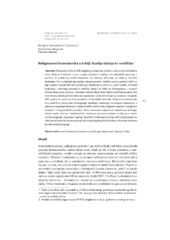Приказ основних података о документу
Religioznost hodočasnika u Srbiji: Studija slučaja tri svetilišta
Religiosity of pilgrims in Serbia : case study of three sanctuares
| dc.contributor.editor | Milidrag, Predrag | |
| dc.creator | Radisaljvević Ćiparizović, Dragana | |
| dc.date.accessioned | 2017-11-01T10:17:24Z | |
| dc.date.available | 2017-11-01T10:17:24Z | |
| dc.date.issued | 2012 | |
| dc.identifier | 0353-5738 | |
| dc.identifier.uri | http://rifdt.instifdt.bg.ac.rs/123456789/1087 | |
| dc.description.abstract | Pilgrimage is an ancient form of religious expression, inherent in almost every confession. Modern pilgrimage differs from past pilgrim travels in various attributes. Pilgrimages contribute to the tourism development because they affect interreligious and international communication. In the first place, significance and topicality of the subject is explained, and basic concepts are defined (pilgrimage, religious tourism, contemporary pilgrim). After that, a theoretical and methodological framework has been provided. Research relays to religious and ethical „mixed“ pilgrimages and also includes Orthodox chancels: St. Petka’s chapel in Kalemegdan and Madonna of Đunis monastery and catholic chancel Madonna of Tekije near Petrovaradin. These places are visited regardless of the visitor's faith. In depth interviews were conducted in 2007 in Belgrade, and the sample consisted of 25 Orthodox and 25 Catholic interviewees. We were monitoring religiosity of pilgrims through time by using three categories: upbringing, conversion, and self-assessment of religiosity. Regarding the category of upbringing, three groups were identified: those with a traditional religious formation, an irreligious formation, and those from devotional families. According to the self-assessement of religiosity, the following typology was formed: assured and practical believer, missionary, and traditionalist. We noticed three straight lines in believers’ religious life: progression, stagnation and regression. The results of this exploration confirm that family influence on examinees’ religiosity is strong, but the key category for progression in their religious lives is conversion understood as a dynamic category. | eng |
| dc.format | 23 1 (2012) 53-68 | |
| dc.format | application/pdf | |
| dc.language | sr | |
| dc.relation | info:eu-repo/grantAgreement/MESTD/Basic Research (BR or ON)/179049/RS// | |
| dc.rights | openAccess | |
| dc.rights.uri | https://creativecommons.org/licenses/by-nc-nd/4.0/ | |
| dc.source | Filozofija i društvo/Philosophy and Society | mul |
| dc.subject | mešovita hodočašća | |
| dc.subject | mixed pilgrimages | |
| dc.subject | hodočasnici | |
| dc.subject | pilgrims | |
| dc.subject | tipologija religioznosti | |
| dc.subject | tipology of religiosity | |
| dc.subject | conversion | |
| dc.subject | obraćenje | |
| dc.subject | Serbia | |
| dc.subject | Srbija | |
| dc.title | Religioznost hodočasnika u Srbiji: Studija slučaja tri svetilišta | sr |
| dc.title | Religiosity of pilgrims in Serbia : case study of three sanctuares | eng |
| dc.type | article | |
| dc.rights.license | BY-NC-ND | |
| dcterms.abstract | Радисаљвевић Ћипаризовић, Драгана; Религиозност ходочасника у Србији: Студија случаја три светилишта; | |
| dc.citation.spage | 53 | |
| dc.citation.epage | 68 | |
| dc.identifier.doi | 10.2298/FID1201053R | |
| dc.type.version | publishedVersion | |
| dc.identifier.fulltext | http://rifdt.instifdt.bg.ac.rs/bitstream/id/4730/1085.pdf |

